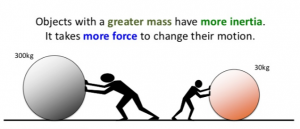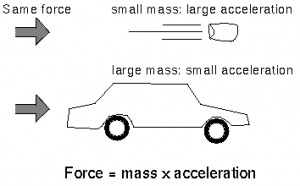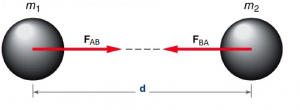NEWTON’S FIRST LAW OF MOTION: Everybody continues to be in a state of rest or uniform motion in a straight line, except in so far as it be compelled by an externally impressed force to act otherwise. INERTIA: It is the inherent property of a body, by virtue of which, the body cannot change its state of rest or of uniform motion along a straight line, on its own. It depends upon the mass of the body.
INERTIA: It is the inherent property of a body, by virtue of which, the body cannot change its state of rest or of uniform motion along a straight line, on its own. It depends upon the mass of the body.
The property which makes the material particle to possess motion inherently, without any kind of interaction, is called inertia.
NEWTON’S SECOND LAW OF MOTION: The rate of change of momentum is directly proportional to the impressed force takes place in the direction of the force.
The net force acting on a particle produces acceleration. The magnitude of the acceleration produced depends on the quantity of matter being acted upon. The quantity of matter is referred to as the Inertial mass. The direction of acceleration is the direction of the net force.
Mathematically,
Fnet = ma,
Fnet includes sum of all external forces. According to 2nd law of motion, rate of change of momentum of a body is proportional to the resultant force acting on the body, i.e. F α (dp/dt).
According to 2nd law of motion, rate of change of momentum of a body is proportional to the resultant force acting on the body, i.e. F α (dp/dt).
Here, the change in momentum takes place in the direction of the applied resultant force. Momentum, P = mv is a measure of the motion contained in the body.
Unit force: It is defined as the force which changes the momentum of a body by unity in unit time. According to this,
F = dp/dt = d/dt (mv) = m (dv/dt) + v dm/dt
If the mass of the system is finite and remains constant w.r.t. time, then (dm/dt) = 0 and
F = m (dv/dt) Fav = p2 – p1/t2 – t1 ΔP/Δt
External force acting on a body may accelerate it either by changing the magnitude of velocity or direction of velocity or both.
If the force is parallel or antiparallel to the motion, it changes only the magnitude v but not the direction and the path followed by the body is a straight line.
If the force acts perpendicular to the motion of body, it changes only the direction but not the magnitude of v and the path follows by the body is a circle (uniform circular motion).
If the force acts at an angle to the motion of a body, it changes both the magnitude and direction of v. In this case path followed by the body may be elliptical, non-uniform circular, parabolic or hyperbolic.
F = dP/dt = m dv/dt
[When mass is constant]
F = ma
F = m [(dvx /dt) i + (dvy/dt) j + (dvz/dt) k]
Fx i + Fy j + Fz k = m [(dvx /dt) i + (dvy/dt) j + (dvz/dt) k]
[Component Form]
[For motion in a plane only two components (say X-Y) are needed].
NEWTON’S THIRD LAW OF MOTION: To every action (Force) there is an equal and opposite reaction (Force). Forces always occur in pair.
Force is the result of mutual interaction between two bodies. Mutual forces between two bodies are always equal and opposite.

Let body B exerts force on body A, body A exerts a force on body B. These forces are related by
FAB = – FBA
The negative sign represents opposite direction. The two forces involved in any interaction between two bodies are called action and reaction. But we cannot say that this particular force is action and the other one is reaction. Action and Reaction always acts on different bodies.
Choice of term action and reaction is arbitrary and there is no cause effect relationship
While studying motion of a body say A, only force acting on body A should be considered.
